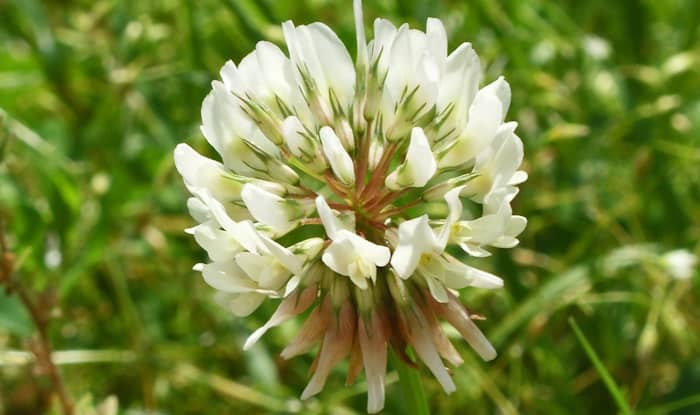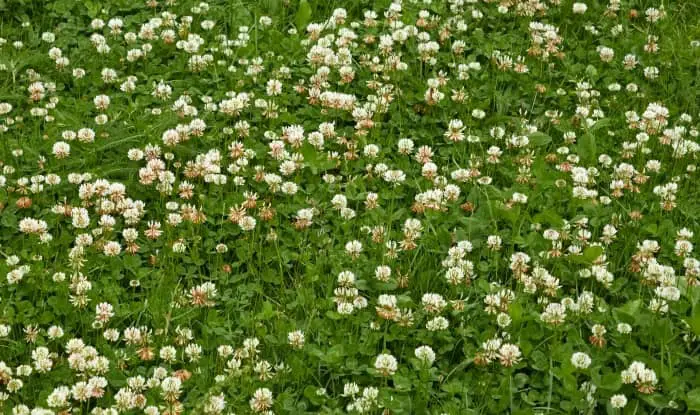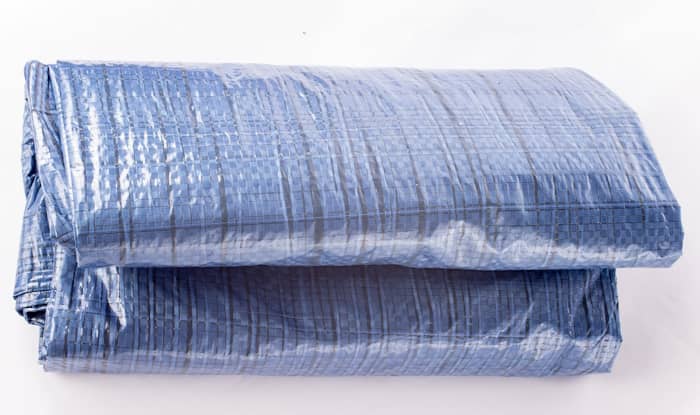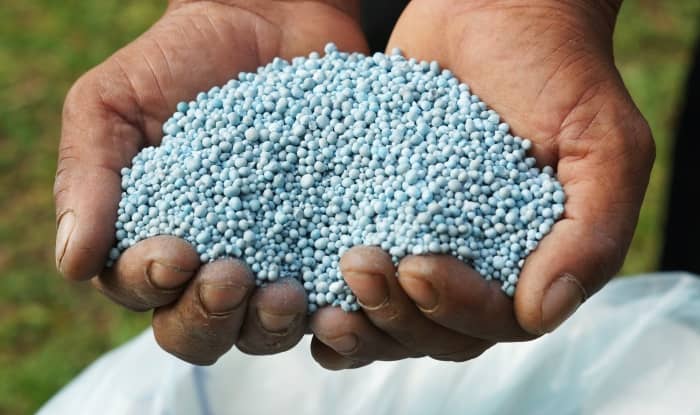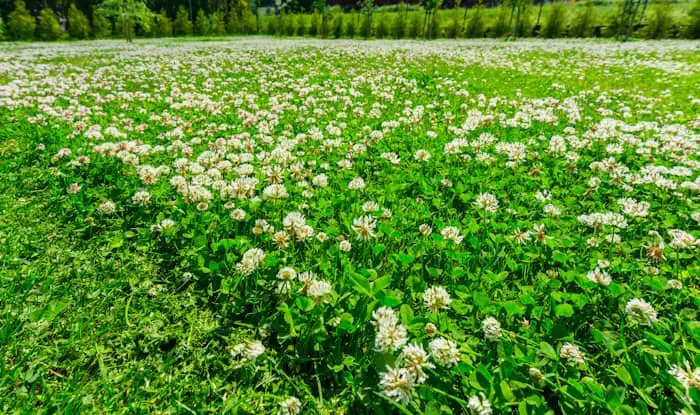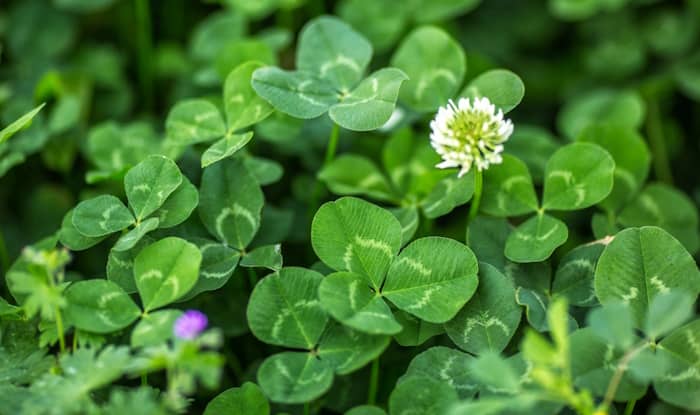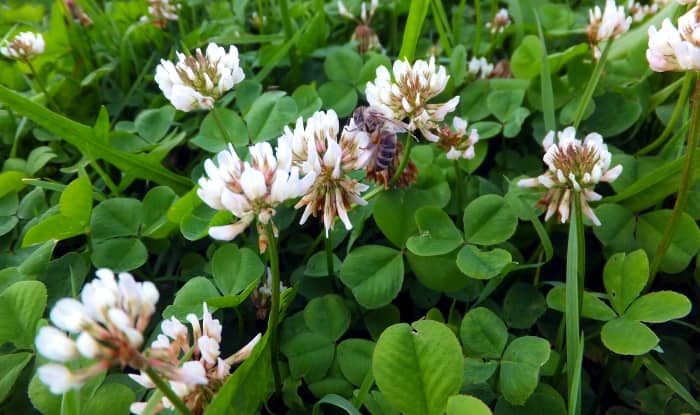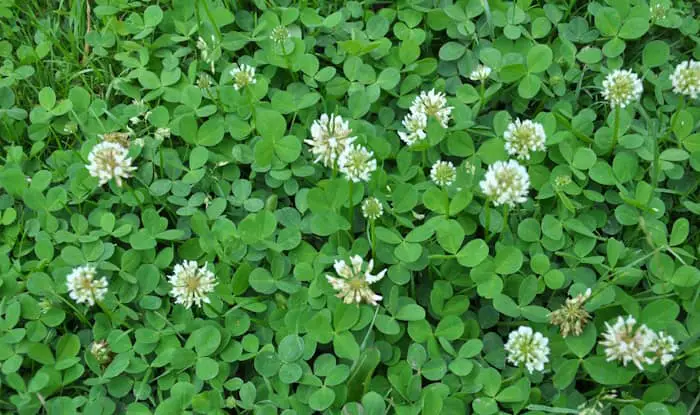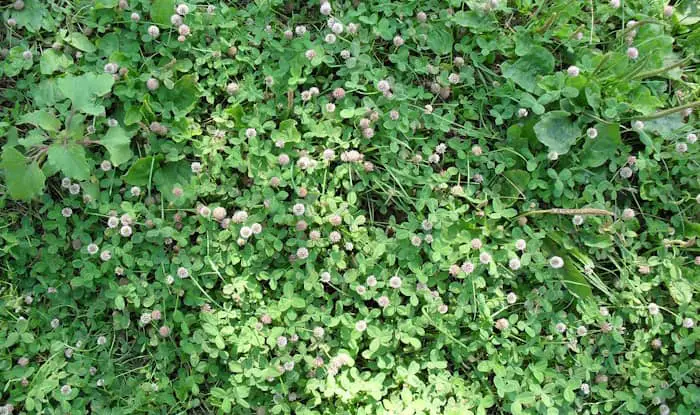If you, like me, have spent a good chunk of your time crouched in your garden, yanking out the stubborn clover that seems to have a knack for invading your well-tended lawn, you’re not alone.
Clover, a trifoliate, unassuming plant that spreads faster than a rumor, can quickly become a bane of a gardener’s existence.
Now, I hear the clover-defenders among you. Yes, clover does have its redeeming qualities. It’s a soil superhero, enriching it with nitrogen, and it serves as a bustling bee metropolis. But when this little green agent starts executing a takeover of your lawn, it’s time to step in.
So, fellow gardeners, our mission today is to equip you with the knowledge and tools to push back against this leafy invader and reclaim your turf.
So, tighten those gardening gloves as I show you how to get rid of clover from your lawn and ensure it doesn’t stage a comeback.
Simple Methods To Eradicate Clover
Pulling by Hand
Gardening, a joyous pastime indeed! Rolling up your sleeves, donning your gloves, and getting hands-on with nature can be an oddly satisfying experience. Amid the myriad of complex gardening techniques, sometimes the simplest methods, like yanking out weeds by hand, hold their ground firmly.
Begin by tenderly loosening the soil around the base of the clover. A spade or your fingers, depending on how horticulturally intimate you wish to be, can do the job.
With the soil now loose and crumbly, the stage is set for the clover to make its exit. The aim is to be thorough, ensuring that you remove all the roots to prevent any unwelcome reappearances.
Using your gloved hands, gently grasp the clover stems near the base and coax them out of the soil. For those deep-seated or obstinate roots, a weed knife or a dandelion digger can prove useful.
Once you’ve bid farewell to the clover patches, it’s critical to inspect your lawn meticulously for any remaining plants or roots. Consider it a form of horticultural proofreading, ensuring no unwelcome guests have overstayed their welcome.
Disposing of the clover plants is your next task. Compost them or bag them up for the trash, the choice is yours.
This method may require some elbow grease, but it’s a natural, eco-friendly, and wallet-friendly alternative. And let’s face it, there’s nothing quite like the satisfaction of gazing upon a clover-free lawn after a day of hard work.
So, green thumbs up, gardeners! Remember, every clover pulled is a triumph for your lawn.
Unleashing the Power of Herbicides
Herbicides are potent chemicals designed to kill those unwelcome plants invading your cherished garden. Yes, you heard right. Those annoying clovers causing havoc every weekend can be easily managed with the right herbicide.
Herbicides come in two varieties – selective and non-selective. Think of selective herbicides as your garden’s private detective, zeroing in on specific nuisances like broadleaf weeds, clover, and certain grass types, leaving your prized turfgrass unscathed.
Non-selective herbicides, in contrast, act more like a sledgehammer, demolishing any plant that dares cross its path.
When it comes to effective clover management, certain herbicides stand out from the crowd. Products containing a unique blend of three active ingredients, Dichlorophenoxyacetic acid (2,4-D), Mecoprop (MCPP), and Dicamba are particularly effective.
While these may sound like tongue twisters, they are the MVPs of the herbicide world. These chemicals imitate plant hormones, disrupting clover’s growth and development, causing it to shrivel up and die. Picture them as the rollercoaster ride the clover just can’t handle!
The best time to apply herbicides to clover is when the plant has finished blooming. This is when it’s most vulnerable, and the herbicide can perform its magic.
Organic Herbicides: The Natural Touch in Weed Control
Organic herbicides, nature’s little helpers, are natural substances that can aid us in our gardening battles.
The most popular organic herbicide is high-strength vinegar containing around 20-30% acetic acid. Some people like to mix it with dish soap so the mixture sticks to the foliage increasing the burning effect.
Other organic herbicides include citric acid, citrus oils (containing d-limonene), and pelargonic acid.
However, it’s not all sunshine and roses. Organic herbicides are non-selective – they can’t differentiate between turfgrass and the pesky clover. So, in your mission to expel clover, precision is crucial to avoid unintentional harm to your grass or other plants.
The Natural Route: Depriving Clover of Oxygen and Sunlight
Like all plants, clover needs oxygen and sunlight to survive. So, a simple and natural method of weed removal is to suffocate the clover into non-existence. Sounds a bit brutal? Well, those obstinate clover patches won’t remove themselves, will they?
The most effective way to do this is by using sturdy, opaque plastic sheeting or even a garbage bag. You need a material that will completely cover the clover patch, blocking out all sunlight and air. Think of it as a cloak of invisibility for the clover. But instead of making it disappear instantly, you’re methodically starving it.
The key here is to secure the plastic covering effectively. You don’t want any defiant sun rays or breaths of fresh air sneaking in there. Stakes or heavy objects usually do the trick to keep the cover in place. A little wind won’t ruin our clover eradication plan!
Once you’ve cloaked the clover, it’s all about patience. The lack of oxygen and sunlight will cause the clover to wither away. It sounds ruthless, but sometimes, gardening demands a little ruthlessness.
Usually, the clover will capitulate in a few weeks. However, the waiting period can vary depending on the resilience of your clover patch. Once it’s dead, rake it up and say adios!
A Word Of Caution
This method isn’t always suitable. If you’ve got a large clover patch devoid of lawn grass in the middle, you’re good to go. But if there’s surrounding grass or other plants, this strategy might cause collateral damage. The plastic covering can inadvertently harm the surrounding vegetation as well.
So there you have it, folks! A natural, chemical-free method to kill clover. It requires some patience, but the satisfaction of seeing those pesky clover patches gone will be worth it.
The Battle Against Clover: Strategies to Keep Your Lawn Flourishing
Regular lawn maintenance is one of the best ways to keep clover at bay. Here’s how you can go about it:
The Secret to a Thriving Lawn: Nutrient-Rich Soil
Imagine this scenario: you’ve been diligently tending to your lawn for hours, only to discover that insidious clover patches have infiltrated your verdant oasis. It’s an all-too-common predicament we gardeners find ourselves in.
Clover isn’t just any ordinary weed; it’s a resourceful plant skilled at self-sustenance. Thanks to its ability to extract nitrogen from the air and utilize it for its growth (1), it leaves your grass gasping for nutrients in the soil. Clover can flourish even in low-nitrogen conditions where grass struggles to establish a foothold.
So, how do you outsmart this nitrogen-hoarding weed? The key is maintaining a nutrient-rich lawn. By regularly fertilizing your lawn, you can boost the nitrogen levels in the soil, giving your grass a competitive edge over clover and other weeds.
Think of it as providing your lawn with a hearty breakfast. A well-nourished lawn is a robust lawn, and a robust lawn is your strongest shield against the encroachment of clover.
Selecting the Ideal Fertilizer for Your Lawn
Deep breath, don’t let the vast world of fertilizers intimidate you. Despite the seemingly endless options, when it comes to lawn care, fertilizers can be categorized into three main groups:
Synthetic fertilizers
Picture these as the fast food of lawn care. They offer a quick, potent dose of nitrogen, transforming your grass into a lush green carpet in no time. They’re budget-friendly and pretty straightforward to use.
However, like fast food, they’re not without their drawbacks. Overuse or incorrect application can risk harming your grass, and potential runoff can pollute nearby water bodies.
The ideal time to apply these fertilizers is during the spring and fall seasons, and remember, it’s crucial to follow the instructions on the label.
Organic fertilizers
Think of these as home-cooked meals for your lawn. Sourced from natural materials like compost, manure, or bone meal, they provide a slow and steady release of nitrogen. They’re gentle on your lawn and kind to the environment, but they do come with a slightly heftier price tag, and the results aren’t instant.
The best time to apply these organic goodies is at the beginning of spring and the end of fall. And, you guessed it, adhering to the instructions on the label is key.
Sulfate of ammonia
This synthetic fertilizer is the lawn’s secret weapon against clover. Loaded with a high nitrogen concentration, it promotes vigorous grass growth while discouraging clover spread.
Application intervals should be six to eight weeks apart, and, once again, following the label directions is paramount.
Keep in mind, that feeding your lawn regularly with the right fertilizer not only boosts its appearance but also strengthens it against clover infestation, allowing it to stand tall and proud. So, choose your lawn’s meal wisely. It’s one of the best gifts you can give your grass and your most potent weapon against clover invasion.
The Mowing Height Solution
The secret to taming clover might be as simple as adjusting your lawnmower’s blade.
You’re likely thinking, “Mowing height? Really?” I shared your skepticism initially. However, after testing this method on my own lawn, I became a believer. So, let’s get down to the nitty-gritty.
Clover thrives under certain conditions. It adores low-cut, nitrogen-deficient terrains. If you’ve been giving your lawn a crew cut or have been lax with your fertilizing schedule, you’re practically laying out a welcome mat for these little interlopers.
The key to keeping clover at bay involves mowing your lawn more frequently and at a higher setting.
It might puzzle you as to why this works. It’s simple. Regular mowing promotes robust grass growth and reduces lawn stress, much like regular trims promote healthier hair. By setting your mower to a higher height, you’re encouraging your grass to thrive and making it harder for clover to gain a foothold.
The Risks of Low-Cut Lawns
Here’s a lawn care tidbit I wish I had known sooner: mowing your lawn too short is like sending a personalized invite to the clover colony. Short grass exposes the soil to more sunlight, creating a perfect environment for clover seeds to sprout. Moreover, clover, being a bit stunted in growth, can survive better than your grass in a closely shorn lawn.
Imagine the last time you had a notably short haircut and how the sun singed your scalp. Your lawn experiences a similar discomfort when cut too low. An image that none of us wants to envision.
In Conclusion…
While adjusting your mowing height may seem like a minor modification, it can make a significant impact in your fight against clover.
The Power of Pre-Emergent Herbicides
Let’s dive headfirst into an effective method for maintaining a clover-free lawn – using pre-emergent herbicides.
It’s essentially your secret ally in the war against clover and other invasive weeds. These products work by preventing weed seeds from sprouting before they even get a chance to see the light of day. Believe me, my lawn is a testament to their effectiveness; it’s a lush green haven devoid of any clovers!
The Importance of Timing
In the world of pre-emergent herbicides, timing is not just critical—it’s everything. Your goal is to intercept those troublesome clover seeds before they awaken and begin their onslaught.
The optimal time to apply your pre-emergent herbicide is during the fall, before the first frost, and again in the spring, before the soil temperature reaches 55 degrees.
How do you know when your soil hits that sweet spot? It’s easy. A simple soil thermometer, inserted about 2 inches below the surface, will do the trick. My go-to soil thermometer is a small but mighty tool that has been worth its weight in gold!
Correct Application of Pre-Emergent Herbicide
When deploying pre-emergent herbicides, it’s vital to follow the label instructions to a tee, particularly when it comes to the rate of application. Aim for a uniform coating of the herbicide on your lawn—avoid overlapping or missing spots.
Picture it like this: if you were applying sunscreen on a sunny day, you wouldn’t want to skip a spot and risk getting burned, would you? The same principle applies here.
After the herbicide application, remember to water your lawn, unless the label instructions advise otherwise. This step activates the herbicide and assists it in creating a chemical barrier in the soil.
The Organic Option: Corn Gluten
For those of you like me, who prefer natural alternatives whenever feasible, corn gluten could be your answer to clover problems. This organic pre-emergent works wonders at keeping clovers at bay without subjecting your lawn to harsh chemicals.
And there you have it! This is part of my annual strategy for combating the clover invasion. A little bit of planning, precise application, and regular watering. Always remember, the best offense is a well-planned defense!
What’s Causing Clover in My Lawn?
Understanding the conditions that encourage clover growth can help you keep it out of your lawn. Here are some of the things to look out for:
Over-Fertilization
Too much of a good thing can be a problem. Over-fertilizing creates an excess of nutrients in the soil, which can work against your grass.
Soil pH
Soil pH is like the teeter-totter of our childhood playground days. Just as maintaining balance was crucial to avoid a face-plant, so is monitoring your soil’s pH levels.
Grass thrives in neutral to slightly acidic soil, preferring a pH range of 6.0 to 7.0. But, the cheeky clover can grow in a wider pH range, from 4.5 to 8.0 (2). If your soil’s pH veers off balance, your grass could suffer, making room for clover to take over.
Compacted Soil
When soil particles become compacted, air circulation reduces, and root growth suffers. Your grass feels the pressure, but clover? It thrives. Clover can break up the compacted soil and improve its structure.
The Low Mowing Misstep
There’s something almost meditative about mowing the lawn, from the hum of the mower to the scent of freshly cut grass. But as mentioned before, beware of cutting your grass too short.
Clover, a low-growing plant, loves sunlight. Mowing the lawn too short can stress your grass and reduce its energy storage. It’s like attempting to run a marathon after a week-long fast.
The Three Common Culprits
Before taking action to recover your lawn, it’s important to identify your adversaries: white clover, red clover, and the stealthy micro clover.
White Clover
White clover (Trifolium repens) is the unwelcome guest at your lawn party who just won’t take a hint. This variant sports clusters of dainty white flowers and trifoliate leaves, each leaflet bearing a white crescent or the signature “V” spot. They’re about half an inch long and more rounded than their clover kin.
The first time I locked eyes with a white clover, it was playing hide and seek with my garden gnome, its tiny white flowers swaying in the breeze. I thought it was a charming little addition to my lawn. Little did I realize it was an invader under the guise of innocence!
Red Clover
Our next culprit is the red clover (Trifolium pratense), the vibrant cousin of the white clover. Standing out with its pinkish blooms, this variant has similar trifoliate leaves to the white clover, but they’re more oval-shaped.
A fellow gardener I know once humorously referred to red clover as the ‘cherry on top’ of our gardening dilemmas. I couldn’t agree more, it’s a pretty pest that packs a punch.
Microclover
Our final adversary is the microclover (Trifolium repens var. Pirouette & Pipolina). This smaller cousin of the white clover sports tinier leaflets and flowers. It’s also quite the master of camouflage, preferring to grow closer to the ground than the others.
Imposters: Spot the Differences
It’s easy to confuse other weeds for clover. Frequent offenders include oxalis or woodsorrel, flaunting heart-shaped leaves, and black medic with its telltale oval-shaped leaves.
Here’s a handy tip: true clover sets itself apart with its distinctive flowers, white markings on the leaves, and its ability to fix nitrogen in the soil.
The Reasons for Clover Removal
The Aesthetic Appeal: Achieving a Uniform Lawn
Ever cast your eyes over your lawn only to see a sprinkling of white clover flowers disrupting your sea of green grass?
Now, as a lover of natural diversity, I can appreciate the contrast. However, for those of us who crave that clean, golf-course aesthetic, these mismatched shapes and slightly off-green leaves can be an eyesore.
And here’s a fun scenario: picture yourself lounging with your favorite book on a sunny Sunday, only to be joined by an unexpected picnic of rabbits feasting on your clover patches. And let’s not forget the buzz of bees that clover attracts! It’s like having your very own Animal Planet episode right in your backyard.
The Turf War: Grass vs. Clover
Next time you admire your garden, pay close attention to the silent battle being waged among your plants. It’s a fierce competition for resources like nutrients, water, and sunlight, with clover and grass being the main contenders.
Clover can be a resource hog, outcompeting your precious lawn grass for these essentials, potentially leading to a less lush green carpet. And those cute bunnies from our earlier scenario? They’re just the tip of the iceberg. Clover can also host diseases and pests (3), like the notorious powdery mildew and the dreaded clover mites.
I learned the hard way a couple of summers back when I decided to ignore the clover on my lawn. The result? A mite infestation no horror movie could do justice to. My poor grass didn’t stand a chance!
The Hidden Dangers: Allergies
Here’s a surprising fact: clover can trigger allergic reactions. Yes, this seemingly innocent plant can cause everything from skin rashes to hay fever and even asthma in some people and pets.
So, while clover might seem harmless and even somewhat charming, it can be a real downer for allergy sufferers. Powerful reasons to consider a clover-free lawn, don’t you think?
The Hidden Perks of Clover in Your Lawn
If you think all of this sounds like too much work, you don’t have to remove clover from your lawn. It has some benefits as well:
The Little Green Factory: Natural Fertilizer
Ever found yourself in an unending cycle of purchasing and applying fertilizer to your lawn? Here’s a fun fact: nature might already be lending you a hand through clover patches.
Clover, a member of the legume family like peas and beans, has a unique knack for generating and sharing nitrogen with surrounding grass. It does so by harboring beneficial bacteria within its roots, which capture nitrogen from the atmosphere and convert it into a plant-friendly form.
The upshot? You have a self-sustaining, organic fertilizer factory in your backyard, courtesy of clover. Say goodbye to those costly and chemically laden lawn feeds!
Quenching the Thirst: Water Conservation
Clover could be your lawn’s unsung hero during those sweltering summer months. Unlike regular grass, clover can tap into and retain water deep in the soil, thanks to its extensive root system. This makes it resilient during droughts and enables it to absorb water beyond the reach of your grass.
Gone could be the days when your lawn turned brown and brittle under the relentless summer sun. With clover, it’s as if your lawn has a built-in irrigation system sans the steep water bill. A win-win, wouldn’t you agree?
The Friendly Competitor: Weed Control
Tired of those pesky weeds spoiling the lush green carpet of your lawn? Clover could be the solution you’ve been seeking.
As it turns out, clover doesn’t get along with other weeds. It competes for essential resources like nutrients, sunlight, and space, effectively suppressing the growth of other weeds. The result? Instead of a weed-ridden lawn, you’ll have a clover-filled one, offering a velvety feel and a unique aesthetic appeal.
The Toughie: Disease Resistance
Experience has taught me that clover is one tenacious little plant. Unlike grass, which often falls prey to many diseases, clover stands tall against many common lawn diseases.
So, the next time a lawn disease threatens to ruin your backyard paradise, remember that clover might just be the green knight in shining armor you need. It’s like having a little green warrior safeguarding your lawn against diseases. Who could resist that?
References:
- White Clover Establishment and Management Guide – https://extension.uga.edu/publications/detail.html?number=B1251&title=white-clover-establishment-and-management-guide
- Responses of Alfalfa, Red Clover, and White Clover to Soil pH and Lime Treatments – https://www.researchgate.net/publication/249306110_Responses_of_Alfalfa_Red_Clover_and_White_Clover_to_Soil_pH_and_Lime_Treatments
- Clover – https://plantvillage.psu.edu/topics/clover/infos
